Business Law Report: Negligence, Misrepresentation, and Business Torts
VerifiedAdded on 2020/03/23
|8
|2922
|36
Report
AI Summary
This report provides a comprehensive overview of business law, focusing on the concepts of negligence and misrepresentation. It defines negligence as the failure to exercise proper care, leading to potential lawsuits under the Civil Liability Act 2002 (NSW), and misrepresentation as presenting false facts to induce contracts. The report explores the elements required to prove these torts, including duty of care, breach of duty, and causation, while also examining defenses available to defendants, such as the presumption of risk and contributory negligence. Several real-life case studies illustrate how businesses have been held liable for their actions. Furthermore, the report discusses the role of public officers and statutory authorities in relation to negligence and the various types of business torts, including unfair competition, restraint of trade, wrongful interference, computer-related torts, and disparagement. The report emphasizes the importance of tortious principles in ensuring fair business practices and providing remedies for those harmed by negligent or misrepresented actions, with the court considering both current and future damages when determining awards.
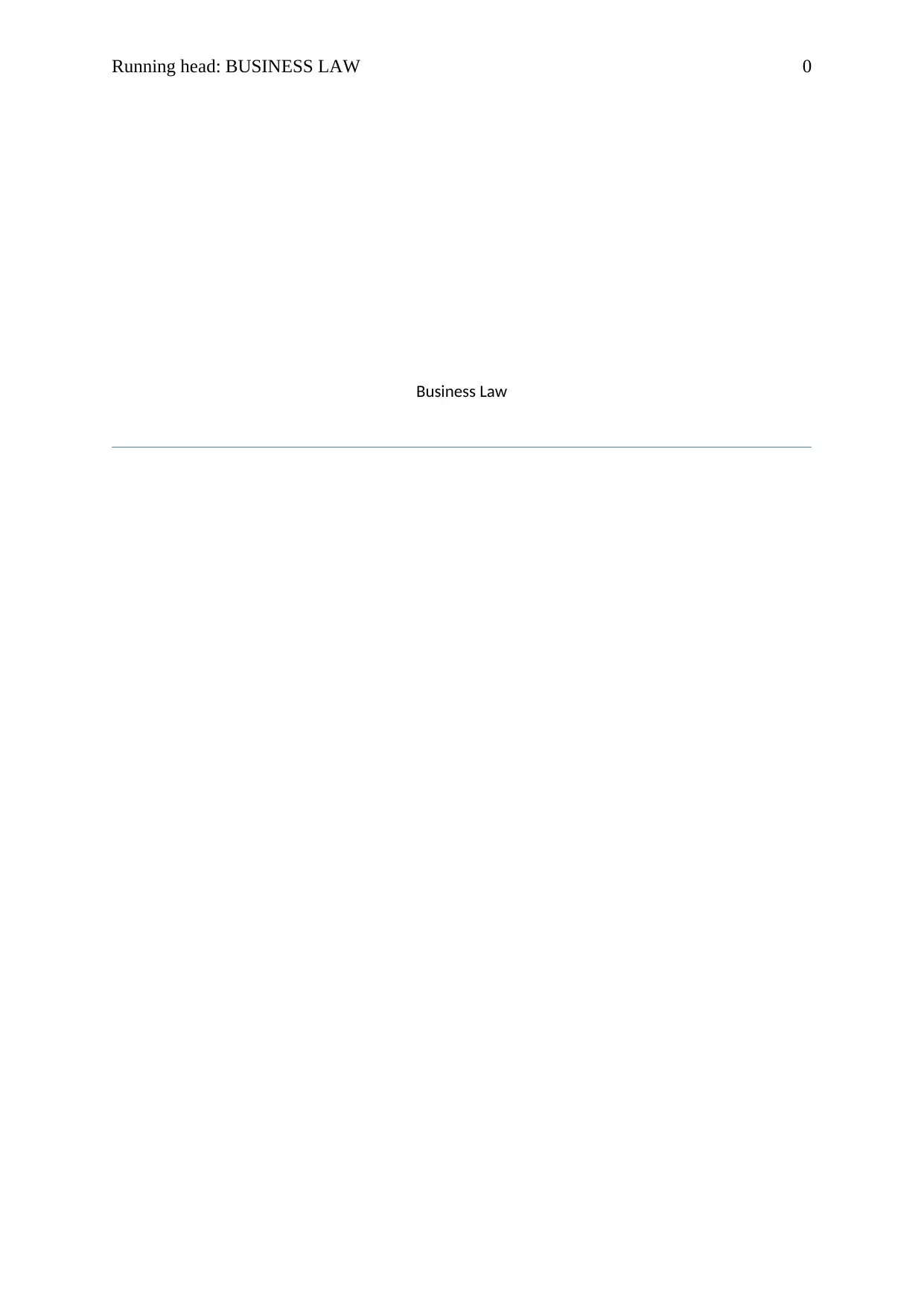
Running head: BUSINESS LAW 0
Business Law
Business Law
Paraphrase This Document
Need a fresh take? Get an instant paraphrase of this document with our AI Paraphraser
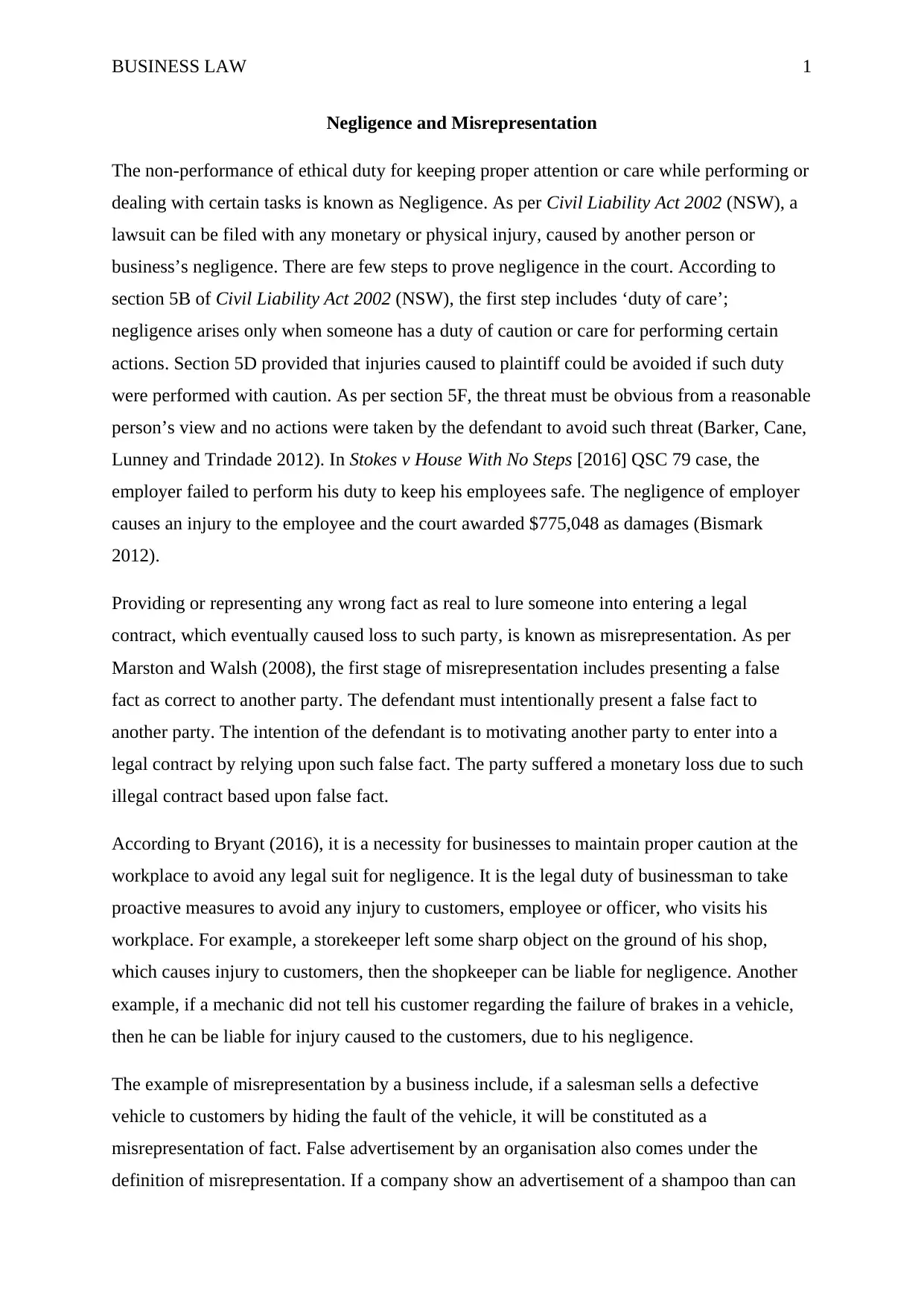
BUSINESS LAW 1
Negligence and Misrepresentation
The non-performance of ethical duty for keeping proper attention or care while performing or
dealing with certain tasks is known as Negligence. As per Civil Liability Act 2002 (NSW), a
lawsuit can be filed with any monetary or physical injury, caused by another person or
business’s negligence. There are few steps to prove negligence in the court. According to
section 5B of Civil Liability Act 2002 (NSW), the first step includes ‘duty of care’;
negligence arises only when someone has a duty of caution or care for performing certain
actions. Section 5D provided that injuries caused to plaintiff could be avoided if such duty
were performed with caution. As per section 5F, the threat must be obvious from a reasonable
person’s view and no actions were taken by the defendant to avoid such threat (Barker, Cane,
Lunney and Trindade 2012). In Stokes v House With No Steps [2016] QSC 79 case, the
employer failed to perform his duty to keep his employees safe. The negligence of employer
causes an injury to the employee and the court awarded $775,048 as damages (Bismark
2012).
Providing or representing any wrong fact as real to lure someone into entering a legal
contract, which eventually caused loss to such party, is known as misrepresentation. As per
Marston and Walsh (2008), the first stage of misrepresentation includes presenting a false
fact as correct to another party. The defendant must intentionally present a false fact to
another party. The intention of the defendant is to motivating another party to enter into a
legal contract by relying upon such false fact. The party suffered a monetary loss due to such
illegal contract based upon false fact.
According to Bryant (2016), it is a necessity for businesses to maintain proper caution at the
workplace to avoid any legal suit for negligence. It is the legal duty of businessman to take
proactive measures to avoid any injury to customers, employee or officer, who visits his
workplace. For example, a storekeeper left some sharp object on the ground of his shop,
which causes injury to customers, then the shopkeeper can be liable for negligence. Another
example, if a mechanic did not tell his customer regarding the failure of brakes in a vehicle,
then he can be liable for injury caused to the customers, due to his negligence.
The example of misrepresentation by a business include, if a salesman sells a defective
vehicle to customers by hiding the fault of the vehicle, it will be constituted as a
misrepresentation of fact. False advertisement by an organisation also comes under the
definition of misrepresentation. If a company show an advertisement of a shampoo than can
Negligence and Misrepresentation
The non-performance of ethical duty for keeping proper attention or care while performing or
dealing with certain tasks is known as Negligence. As per Civil Liability Act 2002 (NSW), a
lawsuit can be filed with any monetary or physical injury, caused by another person or
business’s negligence. There are few steps to prove negligence in the court. According to
section 5B of Civil Liability Act 2002 (NSW), the first step includes ‘duty of care’;
negligence arises only when someone has a duty of caution or care for performing certain
actions. Section 5D provided that injuries caused to plaintiff could be avoided if such duty
were performed with caution. As per section 5F, the threat must be obvious from a reasonable
person’s view and no actions were taken by the defendant to avoid such threat (Barker, Cane,
Lunney and Trindade 2012). In Stokes v House With No Steps [2016] QSC 79 case, the
employer failed to perform his duty to keep his employees safe. The negligence of employer
causes an injury to the employee and the court awarded $775,048 as damages (Bismark
2012).
Providing or representing any wrong fact as real to lure someone into entering a legal
contract, which eventually caused loss to such party, is known as misrepresentation. As per
Marston and Walsh (2008), the first stage of misrepresentation includes presenting a false
fact as correct to another party. The defendant must intentionally present a false fact to
another party. The intention of the defendant is to motivating another party to enter into a
legal contract by relying upon such false fact. The party suffered a monetary loss due to such
illegal contract based upon false fact.
According to Bryant (2016), it is a necessity for businesses to maintain proper caution at the
workplace to avoid any legal suit for negligence. It is the legal duty of businessman to take
proactive measures to avoid any injury to customers, employee or officer, who visits his
workplace. For example, a storekeeper left some sharp object on the ground of his shop,
which causes injury to customers, then the shopkeeper can be liable for negligence. Another
example, if a mechanic did not tell his customer regarding the failure of brakes in a vehicle,
then he can be liable for injury caused to the customers, due to his negligence.
The example of misrepresentation by a business include, if a salesman sells a defective
vehicle to customers by hiding the fault of the vehicle, it will be constituted as a
misrepresentation of fact. False advertisement by an organisation also comes under the
definition of misrepresentation. If a company show an advertisement of a shampoo than can
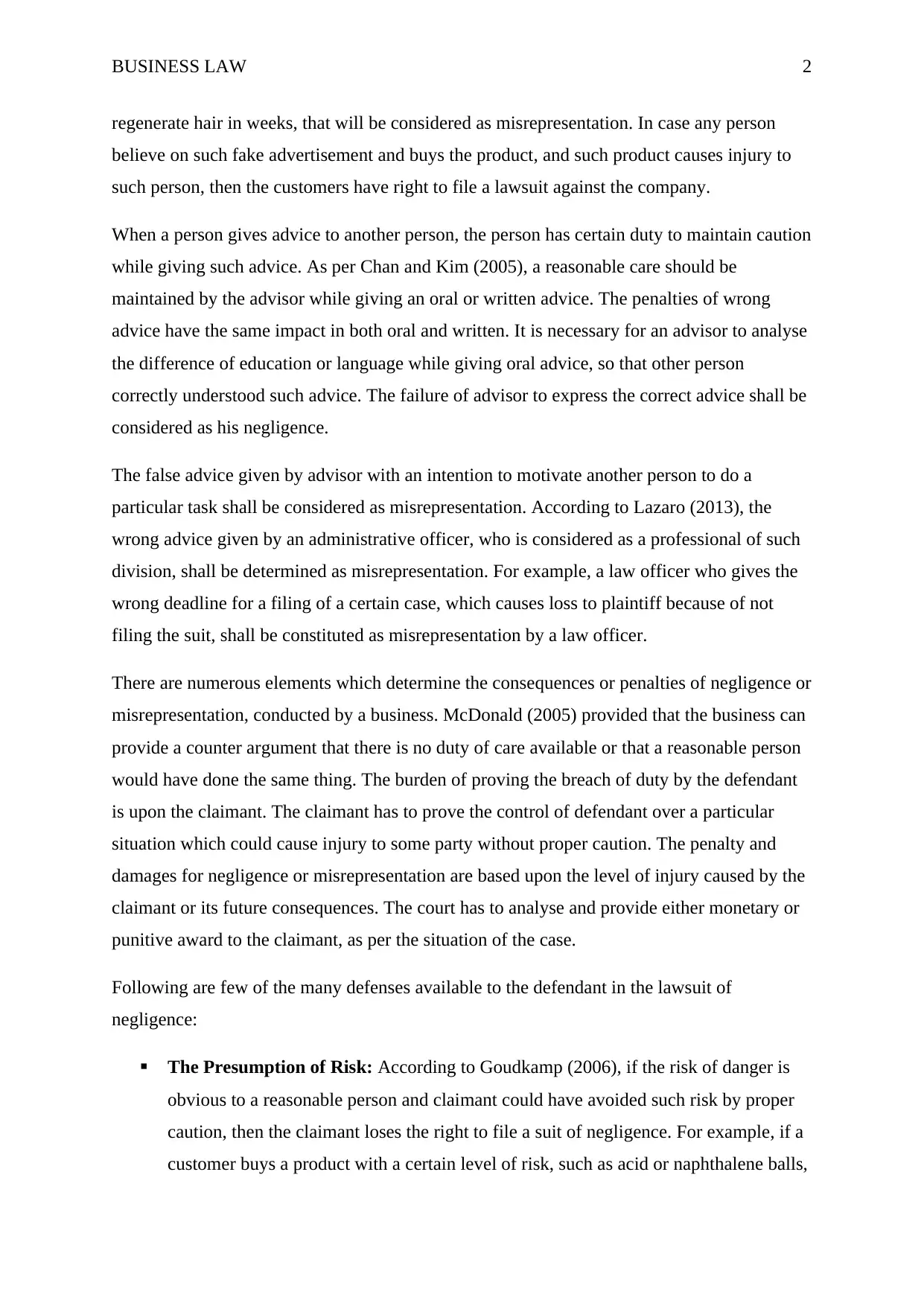
BUSINESS LAW 2
regenerate hair in weeks, that will be considered as misrepresentation. In case any person
believe on such fake advertisement and buys the product, and such product causes injury to
such person, then the customers have right to file a lawsuit against the company.
When a person gives advice to another person, the person has certain duty to maintain caution
while giving such advice. As per Chan and Kim (2005), a reasonable care should be
maintained by the advisor while giving an oral or written advice. The penalties of wrong
advice have the same impact in both oral and written. It is necessary for an advisor to analyse
the difference of education or language while giving oral advice, so that other person
correctly understood such advice. The failure of advisor to express the correct advice shall be
considered as his negligence.
The false advice given by advisor with an intention to motivate another person to do a
particular task shall be considered as misrepresentation. According to Lazaro (2013), the
wrong advice given by an administrative officer, who is considered as a professional of such
division, shall be determined as misrepresentation. For example, a law officer who gives the
wrong deadline for a filing of a certain case, which causes loss to plaintiff because of not
filing the suit, shall be constituted as misrepresentation by a law officer.
There are numerous elements which determine the consequences or penalties of negligence or
misrepresentation, conducted by a business. McDonald (2005) provided that the business can
provide a counter argument that there is no duty of care available or that a reasonable person
would have done the same thing. The burden of proving the breach of duty by the defendant
is upon the claimant. The claimant has to prove the control of defendant over a particular
situation which could cause injury to some party without proper caution. The penalty and
damages for negligence or misrepresentation are based upon the level of injury caused by the
claimant or its future consequences. The court has to analyse and provide either monetary or
punitive award to the claimant, as per the situation of the case.
Following are few of the many defenses available to the defendant in the lawsuit of
negligence:
The Presumption of Risk: According to Goudkamp (2006), if the risk of danger is
obvious to a reasonable person and claimant could have avoided such risk by proper
caution, then the claimant loses the right to file a suit of negligence. For example, if a
customer buys a product with a certain level of risk, such as acid or naphthalene balls,
regenerate hair in weeks, that will be considered as misrepresentation. In case any person
believe on such fake advertisement and buys the product, and such product causes injury to
such person, then the customers have right to file a lawsuit against the company.
When a person gives advice to another person, the person has certain duty to maintain caution
while giving such advice. As per Chan and Kim (2005), a reasonable care should be
maintained by the advisor while giving an oral or written advice. The penalties of wrong
advice have the same impact in both oral and written. It is necessary for an advisor to analyse
the difference of education or language while giving oral advice, so that other person
correctly understood such advice. The failure of advisor to express the correct advice shall be
considered as his negligence.
The false advice given by advisor with an intention to motivate another person to do a
particular task shall be considered as misrepresentation. According to Lazaro (2013), the
wrong advice given by an administrative officer, who is considered as a professional of such
division, shall be determined as misrepresentation. For example, a law officer who gives the
wrong deadline for a filing of a certain case, which causes loss to plaintiff because of not
filing the suit, shall be constituted as misrepresentation by a law officer.
There are numerous elements which determine the consequences or penalties of negligence or
misrepresentation, conducted by a business. McDonald (2005) provided that the business can
provide a counter argument that there is no duty of care available or that a reasonable person
would have done the same thing. The burden of proving the breach of duty by the defendant
is upon the claimant. The claimant has to prove the control of defendant over a particular
situation which could cause injury to some party without proper caution. The penalty and
damages for negligence or misrepresentation are based upon the level of injury caused by the
claimant or its future consequences. The court has to analyse and provide either monetary or
punitive award to the claimant, as per the situation of the case.
Following are few of the many defenses available to the defendant in the lawsuit of
negligence:
The Presumption of Risk: According to Goudkamp (2006), if the risk of danger is
obvious to a reasonable person and claimant could have avoided such risk by proper
caution, then the claimant loses the right to file a suit of negligence. For example, if a
customer buys a product with a certain level of risk, such as acid or naphthalene balls,
⊘ This is a preview!⊘
Do you want full access?
Subscribe today to unlock all pages.

Trusted by 1+ million students worldwide
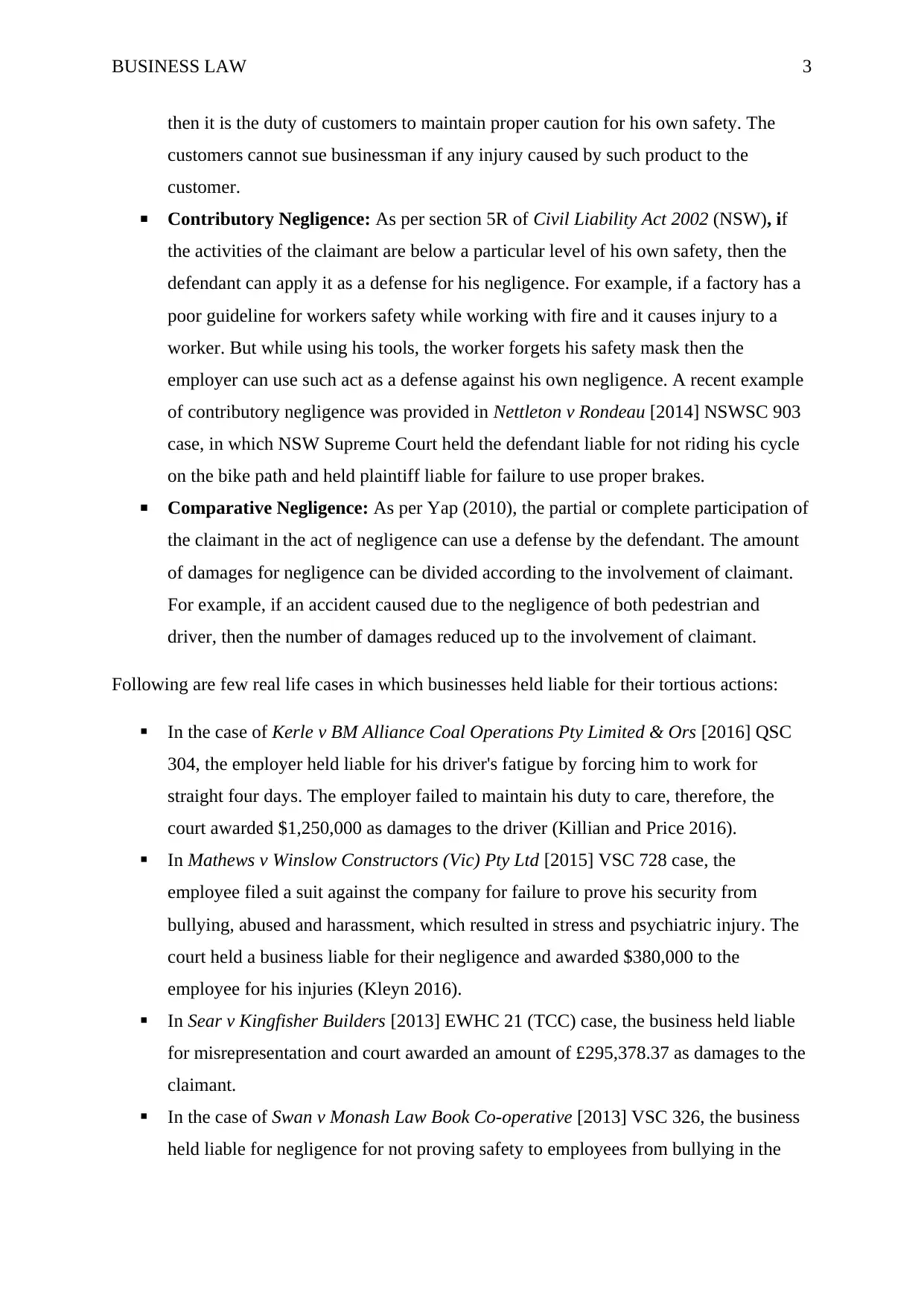
BUSINESS LAW 3
then it is the duty of customers to maintain proper caution for his own safety. The
customers cannot sue businessman if any injury caused by such product to the
customer.
Contributory Negligence: As per section 5R of Civil Liability Act 2002 (NSW), if
the activities of the claimant are below a particular level of his own safety, then the
defendant can apply it as a defense for his negligence. For example, if a factory has a
poor guideline for workers safety while working with fire and it causes injury to a
worker. But while using his tools, the worker forgets his safety mask then the
employer can use such act as a defense against his own negligence. A recent example
of contributory negligence was provided in Nettleton v Rondeau [2014] NSWSC 903
case, in which NSW Supreme Court held the defendant liable for not riding his cycle
on the bike path and held plaintiff liable for failure to use proper brakes.
Comparative Negligence: As per Yap (2010), the partial or complete participation of
the claimant in the act of negligence can use a defense by the defendant. The amount
of damages for negligence can be divided according to the involvement of claimant.
For example, if an accident caused due to the negligence of both pedestrian and
driver, then the number of damages reduced up to the involvement of claimant.
Following are few real life cases in which businesses held liable for their tortious actions:
In the case of Kerle v BM Alliance Coal Operations Pty Limited & Ors [2016] QSC
304, the employer held liable for his driver's fatigue by forcing him to work for
straight four days. The employer failed to maintain his duty to care, therefore, the
court awarded $1,250,000 as damages to the driver (Killian and Price 2016).
In Mathews v Winslow Constructors (Vic) Pty Ltd [2015] VSC 728 case, the
employee filed a suit against the company for failure to prove his security from
bullying, abused and harassment, which resulted in stress and psychiatric injury. The
court held a business liable for their negligence and awarded $380,000 to the
employee for his injuries (Kleyn 2016).
In Sear v Kingfisher Builders [2013] EWHC 21 (TCC) case, the business held liable
for misrepresentation and court awarded an amount of £295,378.37 as damages to the
claimant.
In the case of Swan v Monash Law Book Co-operative [2013] VSC 326, the business
held liable for negligence for not proving safety to employees from bullying in the
then it is the duty of customers to maintain proper caution for his own safety. The
customers cannot sue businessman if any injury caused by such product to the
customer.
Contributory Negligence: As per section 5R of Civil Liability Act 2002 (NSW), if
the activities of the claimant are below a particular level of his own safety, then the
defendant can apply it as a defense for his negligence. For example, if a factory has a
poor guideline for workers safety while working with fire and it causes injury to a
worker. But while using his tools, the worker forgets his safety mask then the
employer can use such act as a defense against his own negligence. A recent example
of contributory negligence was provided in Nettleton v Rondeau [2014] NSWSC 903
case, in which NSW Supreme Court held the defendant liable for not riding his cycle
on the bike path and held plaintiff liable for failure to use proper brakes.
Comparative Negligence: As per Yap (2010), the partial or complete participation of
the claimant in the act of negligence can use a defense by the defendant. The amount
of damages for negligence can be divided according to the involvement of claimant.
For example, if an accident caused due to the negligence of both pedestrian and
driver, then the number of damages reduced up to the involvement of claimant.
Following are few real life cases in which businesses held liable for their tortious actions:
In the case of Kerle v BM Alliance Coal Operations Pty Limited & Ors [2016] QSC
304, the employer held liable for his driver's fatigue by forcing him to work for
straight four days. The employer failed to maintain his duty to care, therefore, the
court awarded $1,250,000 as damages to the driver (Killian and Price 2016).
In Mathews v Winslow Constructors (Vic) Pty Ltd [2015] VSC 728 case, the
employee filed a suit against the company for failure to prove his security from
bullying, abused and harassment, which resulted in stress and psychiatric injury. The
court held a business liable for their negligence and awarded $380,000 to the
employee for his injuries (Kleyn 2016).
In Sear v Kingfisher Builders [2013] EWHC 21 (TCC) case, the business held liable
for misrepresentation and court awarded an amount of £295,378.37 as damages to the
claimant.
In the case of Swan v Monash Law Book Co-operative [2013] VSC 326, the business
held liable for negligence for not proving safety to employees from bullying in the
Paraphrase This Document
Need a fresh take? Get an instant paraphrase of this document with our AI Paraphraser
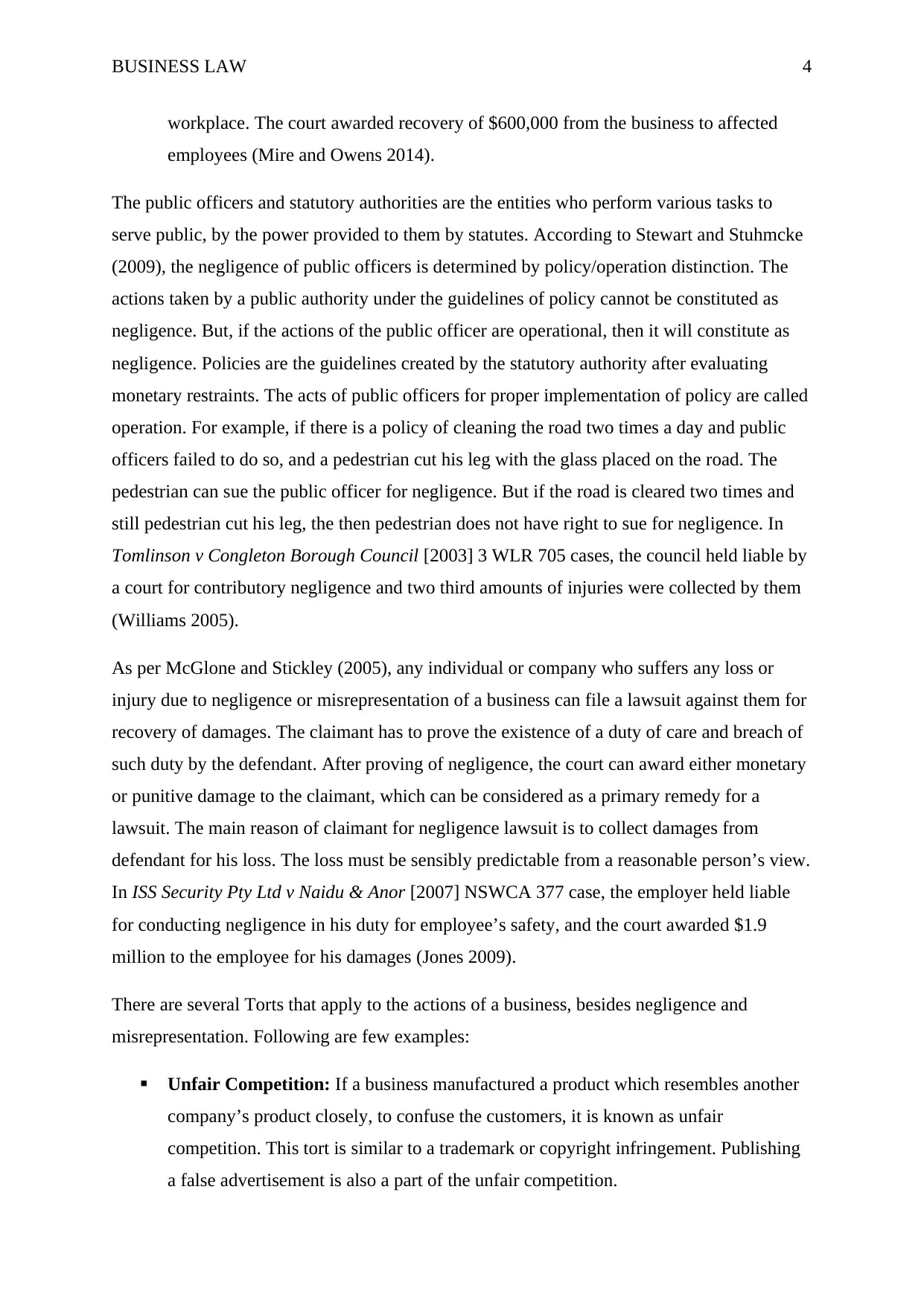
BUSINESS LAW 4
workplace. The court awarded recovery of $600,000 from the business to affected
employees (Mire and Owens 2014).
The public officers and statutory authorities are the entities who perform various tasks to
serve public, by the power provided to them by statutes. According to Stewart and Stuhmcke
(2009), the negligence of public officers is determined by policy/operation distinction. The
actions taken by a public authority under the guidelines of policy cannot be constituted as
negligence. But, if the actions of the public officer are operational, then it will constitute as
negligence. Policies are the guidelines created by the statutory authority after evaluating
monetary restraints. The acts of public officers for proper implementation of policy are called
operation. For example, if there is a policy of cleaning the road two times a day and public
officers failed to do so, and a pedestrian cut his leg with the glass placed on the road. The
pedestrian can sue the public officer for negligence. But if the road is cleared two times and
still pedestrian cut his leg, the then pedestrian does not have right to sue for negligence. In
Tomlinson v Congleton Borough Council [2003] 3 WLR 705 cases, the council held liable by
a court for contributory negligence and two third amounts of injuries were collected by them
(Williams 2005).
As per McGlone and Stickley (2005), any individual or company who suffers any loss or
injury due to negligence or misrepresentation of a business can file a lawsuit against them for
recovery of damages. The claimant has to prove the existence of a duty of care and breach of
such duty by the defendant. After proving of negligence, the court can award either monetary
or punitive damage to the claimant, which can be considered as a primary remedy for a
lawsuit. The main reason of claimant for negligence lawsuit is to collect damages from
defendant for his loss. The loss must be sensibly predictable from a reasonable person’s view.
In ISS Security Pty Ltd v Naidu & Anor [2007] NSWCA 377 case, the employer held liable
for conducting negligence in his duty for employee’s safety, and the court awarded $1.9
million to the employee for his damages (Jones 2009).
There are several Torts that apply to the actions of a business, besides negligence and
misrepresentation. Following are few examples:
Unfair Competition: If a business manufactured a product which resembles another
company’s product closely, to confuse the customers, it is known as unfair
competition. This tort is similar to a trademark or copyright infringement. Publishing
a false advertisement is also a part of the unfair competition.
workplace. The court awarded recovery of $600,000 from the business to affected
employees (Mire and Owens 2014).
The public officers and statutory authorities are the entities who perform various tasks to
serve public, by the power provided to them by statutes. According to Stewart and Stuhmcke
(2009), the negligence of public officers is determined by policy/operation distinction. The
actions taken by a public authority under the guidelines of policy cannot be constituted as
negligence. But, if the actions of the public officer are operational, then it will constitute as
negligence. Policies are the guidelines created by the statutory authority after evaluating
monetary restraints. The acts of public officers for proper implementation of policy are called
operation. For example, if there is a policy of cleaning the road two times a day and public
officers failed to do so, and a pedestrian cut his leg with the glass placed on the road. The
pedestrian can sue the public officer for negligence. But if the road is cleared two times and
still pedestrian cut his leg, the then pedestrian does not have right to sue for negligence. In
Tomlinson v Congleton Borough Council [2003] 3 WLR 705 cases, the council held liable by
a court for contributory negligence and two third amounts of injuries were collected by them
(Williams 2005).
As per McGlone and Stickley (2005), any individual or company who suffers any loss or
injury due to negligence or misrepresentation of a business can file a lawsuit against them for
recovery of damages. The claimant has to prove the existence of a duty of care and breach of
such duty by the defendant. After proving of negligence, the court can award either monetary
or punitive damage to the claimant, which can be considered as a primary remedy for a
lawsuit. The main reason of claimant for negligence lawsuit is to collect damages from
defendant for his loss. The loss must be sensibly predictable from a reasonable person’s view.
In ISS Security Pty Ltd v Naidu & Anor [2007] NSWCA 377 case, the employer held liable
for conducting negligence in his duty for employee’s safety, and the court awarded $1.9
million to the employee for his damages (Jones 2009).
There are several Torts that apply to the actions of a business, besides negligence and
misrepresentation. Following are few examples:
Unfair Competition: If a business manufactured a product which resembles another
company’s product closely, to confuse the customers, it is known as unfair
competition. This tort is similar to a trademark or copyright infringement. Publishing
a false advertisement is also a part of the unfair competition.
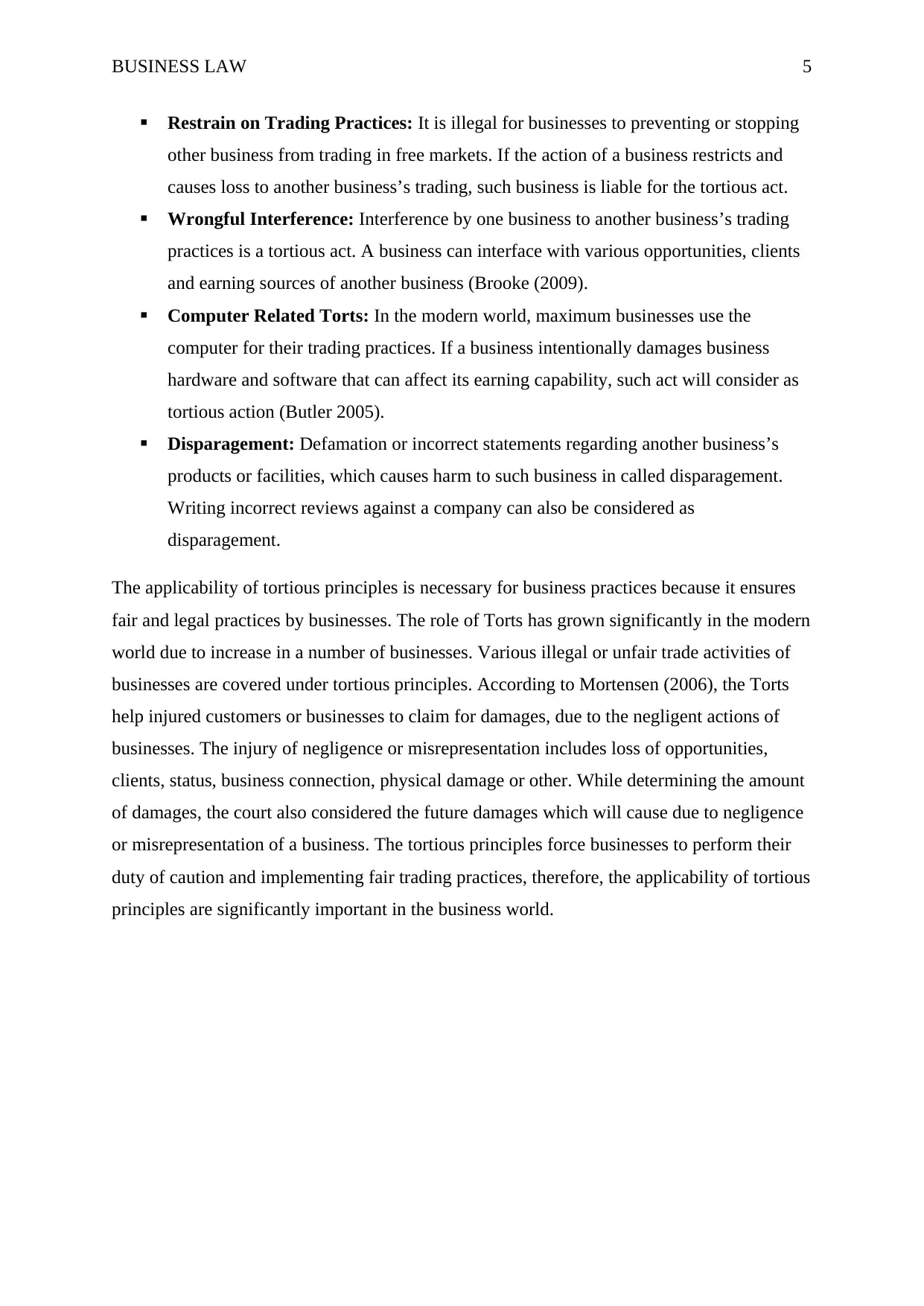
BUSINESS LAW 5
Restrain on Trading Practices: It is illegal for businesses to preventing or stopping
other business from trading in free markets. If the action of a business restricts and
causes loss to another business’s trading, such business is liable for the tortious act.
Wrongful Interference: Interference by one business to another business’s trading
practices is a tortious act. A business can interface with various opportunities, clients
and earning sources of another business (Brooke (2009).
Computer Related Torts: In the modern world, maximum businesses use the
computer for their trading practices. If a business intentionally damages business
hardware and software that can affect its earning capability, such act will consider as
tortious action (Butler 2005).
Disparagement: Defamation or incorrect statements regarding another business’s
products or facilities, which causes harm to such business in called disparagement.
Writing incorrect reviews against a company can also be considered as
disparagement.
The applicability of tortious principles is necessary for business practices because it ensures
fair and legal practices by businesses. The role of Torts has grown significantly in the modern
world due to increase in a number of businesses. Various illegal or unfair trade activities of
businesses are covered under tortious principles. According to Mortensen (2006), the Torts
help injured customers or businesses to claim for damages, due to the negligent actions of
businesses. The injury of negligence or misrepresentation includes loss of opportunities,
clients, status, business connection, physical damage or other. While determining the amount
of damages, the court also considered the future damages which will cause due to negligence
or misrepresentation of a business. The tortious principles force businesses to perform their
duty of caution and implementing fair trading practices, therefore, the applicability of tortious
principles are significantly important in the business world.
Restrain on Trading Practices: It is illegal for businesses to preventing or stopping
other business from trading in free markets. If the action of a business restricts and
causes loss to another business’s trading, such business is liable for the tortious act.
Wrongful Interference: Interference by one business to another business’s trading
practices is a tortious act. A business can interface with various opportunities, clients
and earning sources of another business (Brooke (2009).
Computer Related Torts: In the modern world, maximum businesses use the
computer for their trading practices. If a business intentionally damages business
hardware and software that can affect its earning capability, such act will consider as
tortious action (Butler 2005).
Disparagement: Defamation or incorrect statements regarding another business’s
products or facilities, which causes harm to such business in called disparagement.
Writing incorrect reviews against a company can also be considered as
disparagement.
The applicability of tortious principles is necessary for business practices because it ensures
fair and legal practices by businesses. The role of Torts has grown significantly in the modern
world due to increase in a number of businesses. Various illegal or unfair trade activities of
businesses are covered under tortious principles. According to Mortensen (2006), the Torts
help injured customers or businesses to claim for damages, due to the negligent actions of
businesses. The injury of negligence or misrepresentation includes loss of opportunities,
clients, status, business connection, physical damage or other. While determining the amount
of damages, the court also considered the future damages which will cause due to negligence
or misrepresentation of a business. The tortious principles force businesses to perform their
duty of caution and implementing fair trading practices, therefore, the applicability of tortious
principles are significantly important in the business world.
⊘ This is a preview!⊘
Do you want full access?
Subscribe today to unlock all pages.

Trusted by 1+ million students worldwide
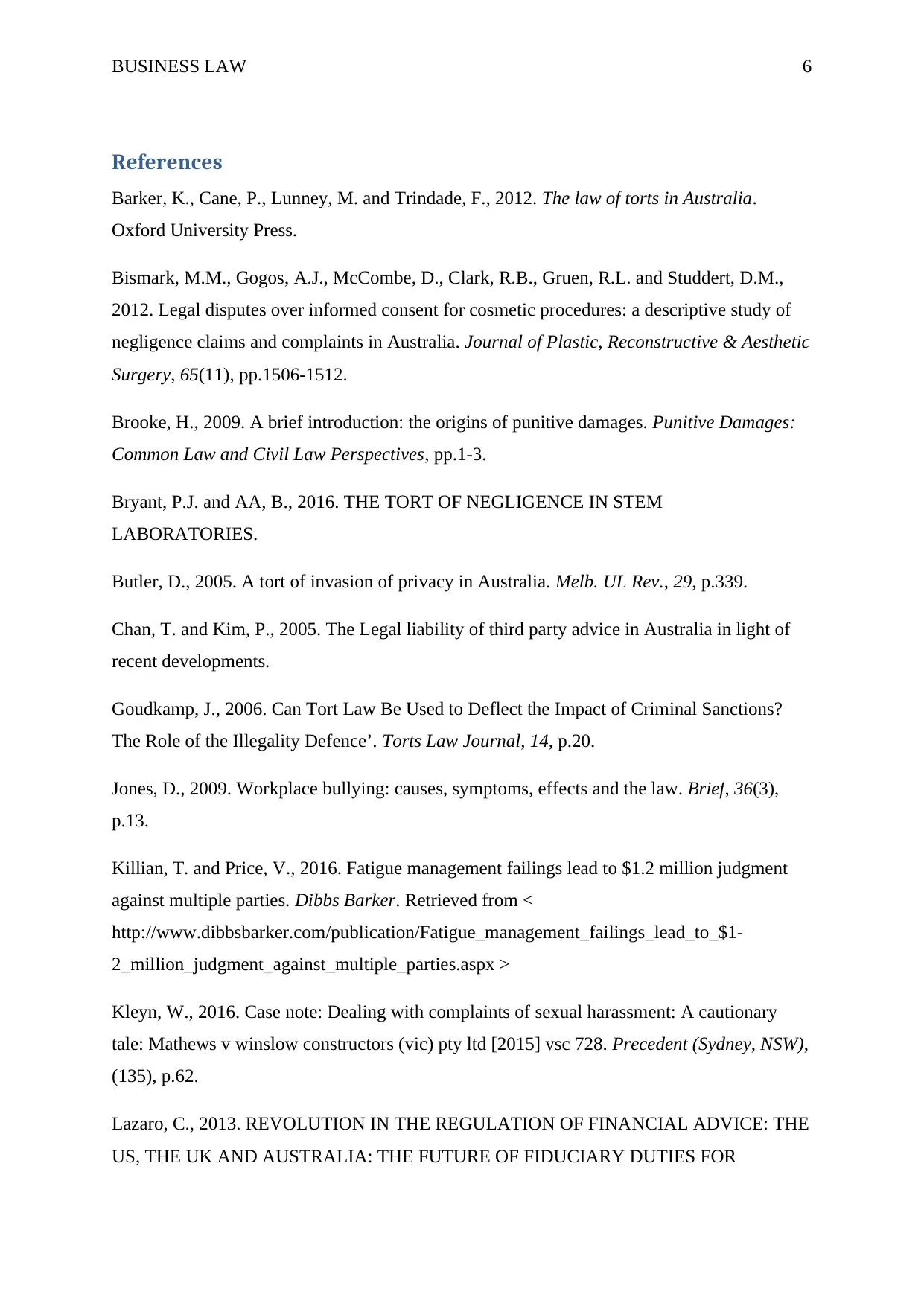
BUSINESS LAW 6
References
Barker, K., Cane, P., Lunney, M. and Trindade, F., 2012. The law of torts in Australia.
Oxford University Press.
Bismark, M.M., Gogos, A.J., McCombe, D., Clark, R.B., Gruen, R.L. and Studdert, D.M.,
2012. Legal disputes over informed consent for cosmetic procedures: a descriptive study of
negligence claims and complaints in Australia. Journal of Plastic, Reconstructive & Aesthetic
Surgery, 65(11), pp.1506-1512.
Brooke, H., 2009. A brief introduction: the origins of punitive damages. Punitive Damages:
Common Law and Civil Law Perspectives, pp.1-3.
Bryant, P.J. and AA, B., 2016. THE TORT OF NEGLIGENCE IN STEM
LABORATORIES.
Butler, D., 2005. A tort of invasion of privacy in Australia. Melb. UL Rev., 29, p.339.
Chan, T. and Kim, P., 2005. The Legal liability of third party advice in Australia in light of
recent developments.
Goudkamp, J., 2006. Can Tort Law Be Used to Deflect the Impact of Criminal Sanctions?
The Role of the Illegality Defence’. Torts Law Journal, 14, p.20.
Jones, D., 2009. Workplace bullying: causes, symptoms, effects and the law. Brief, 36(3),
p.13.
Killian, T. and Price, V., 2016. Fatigue management failings lead to $1.2 million judgment
against multiple parties. Dibbs Barker. Retrieved from <
http://www.dibbsbarker.com/publication/Fatigue_management_failings_lead_to_$1-
2_million_judgment_against_multiple_parties.aspx >
Kleyn, W., 2016. Case note: Dealing with complaints of sexual harassment: A cautionary
tale: Mathews v winslow constructors (vic) pty ltd [2015] vsc 728. Precedent (Sydney, NSW),
(135), p.62.
Lazaro, C., 2013. REVOLUTION IN THE REGULATION OF FINANCIAL ADVICE: THE
US, THE UK AND AUSTRALIA: THE FUTURE OF FIDUCIARY DUTIES FOR
References
Barker, K., Cane, P., Lunney, M. and Trindade, F., 2012. The law of torts in Australia.
Oxford University Press.
Bismark, M.M., Gogos, A.J., McCombe, D., Clark, R.B., Gruen, R.L. and Studdert, D.M.,
2012. Legal disputes over informed consent for cosmetic procedures: a descriptive study of
negligence claims and complaints in Australia. Journal of Plastic, Reconstructive & Aesthetic
Surgery, 65(11), pp.1506-1512.
Brooke, H., 2009. A brief introduction: the origins of punitive damages. Punitive Damages:
Common Law and Civil Law Perspectives, pp.1-3.
Bryant, P.J. and AA, B., 2016. THE TORT OF NEGLIGENCE IN STEM
LABORATORIES.
Butler, D., 2005. A tort of invasion of privacy in Australia. Melb. UL Rev., 29, p.339.
Chan, T. and Kim, P., 2005. The Legal liability of third party advice in Australia in light of
recent developments.
Goudkamp, J., 2006. Can Tort Law Be Used to Deflect the Impact of Criminal Sanctions?
The Role of the Illegality Defence’. Torts Law Journal, 14, p.20.
Jones, D., 2009. Workplace bullying: causes, symptoms, effects and the law. Brief, 36(3),
p.13.
Killian, T. and Price, V., 2016. Fatigue management failings lead to $1.2 million judgment
against multiple parties. Dibbs Barker. Retrieved from <
http://www.dibbsbarker.com/publication/Fatigue_management_failings_lead_to_$1-
2_million_judgment_against_multiple_parties.aspx >
Kleyn, W., 2016. Case note: Dealing with complaints of sexual harassment: A cautionary
tale: Mathews v winslow constructors (vic) pty ltd [2015] vsc 728. Precedent (Sydney, NSW),
(135), p.62.
Lazaro, C., 2013. REVOLUTION IN THE REGULATION OF FINANCIAL ADVICE: THE
US, THE UK AND AUSTRALIA: THE FUTURE OF FIDUCIARY DUTIES FOR
Paraphrase This Document
Need a fresh take? Get an instant paraphrase of this document with our AI Paraphraser
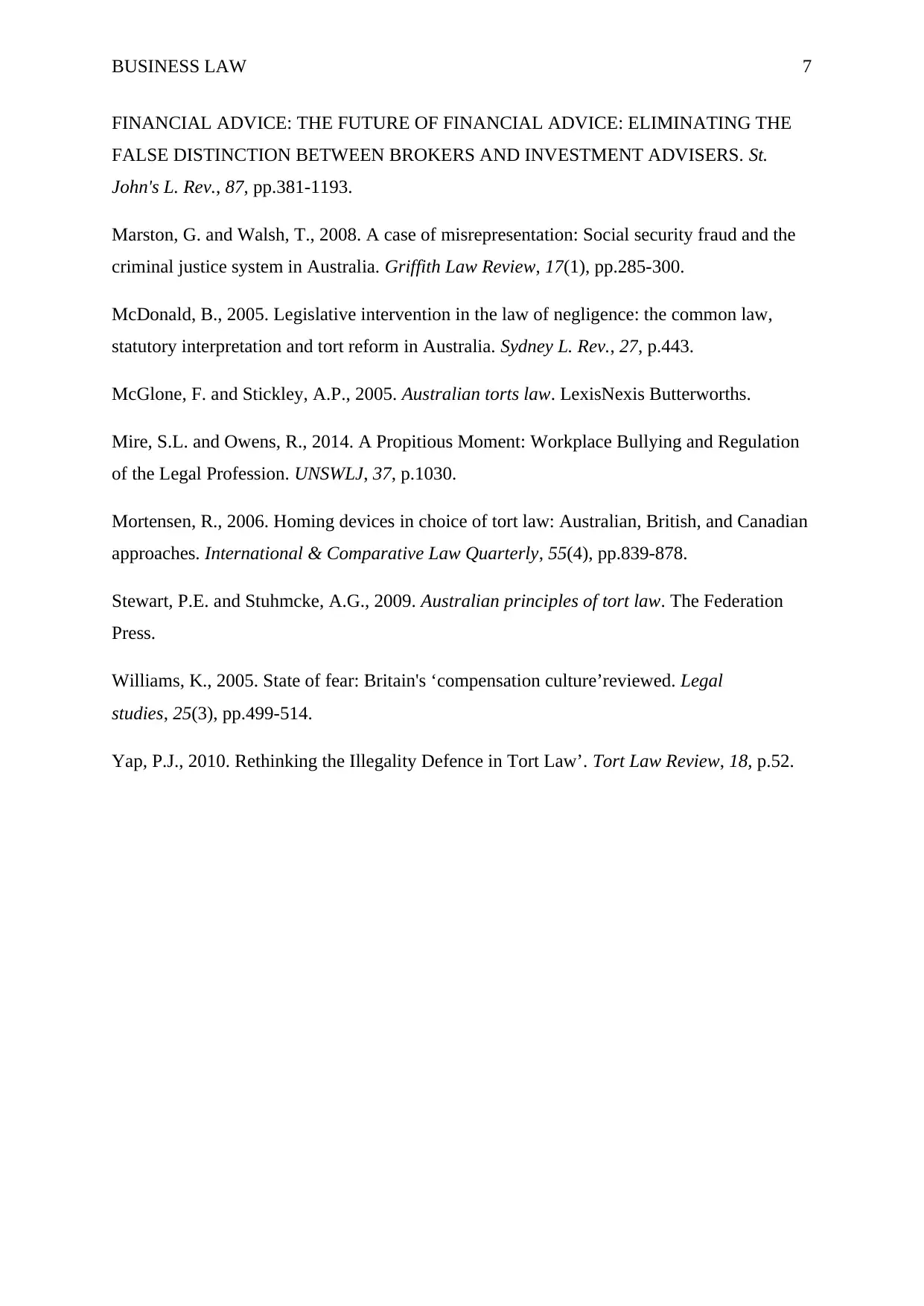
BUSINESS LAW 7
FINANCIAL ADVICE: THE FUTURE OF FINANCIAL ADVICE: ELIMINATING THE
FALSE DISTINCTION BETWEEN BROKERS AND INVESTMENT ADVISERS. St.
John's L. Rev., 87, pp.381-1193.
Marston, G. and Walsh, T., 2008. A case of misrepresentation: Social security fraud and the
criminal justice system in Australia. Griffith Law Review, 17(1), pp.285-300.
McDonald, B., 2005. Legislative intervention in the law of negligence: the common law,
statutory interpretation and tort reform in Australia. Sydney L. Rev., 27, p.443.
McGlone, F. and Stickley, A.P., 2005. Australian torts law. LexisNexis Butterworths.
Mire, S.L. and Owens, R., 2014. A Propitious Moment: Workplace Bullying and Regulation
of the Legal Profession. UNSWLJ, 37, p.1030.
Mortensen, R., 2006. Homing devices in choice of tort law: Australian, British, and Canadian
approaches. International & Comparative Law Quarterly, 55(4), pp.839-878.
Stewart, P.E. and Stuhmcke, A.G., 2009. Australian principles of tort law. The Federation
Press.
Williams, K., 2005. State of fear: Britain's ‘compensation culture’reviewed. Legal
studies, 25(3), pp.499-514.
Yap, P.J., 2010. Rethinking the Illegality Defence in Tort Law’. Tort Law Review, 18, p.52.
FINANCIAL ADVICE: THE FUTURE OF FINANCIAL ADVICE: ELIMINATING THE
FALSE DISTINCTION BETWEEN BROKERS AND INVESTMENT ADVISERS. St.
John's L. Rev., 87, pp.381-1193.
Marston, G. and Walsh, T., 2008. A case of misrepresentation: Social security fraud and the
criminal justice system in Australia. Griffith Law Review, 17(1), pp.285-300.
McDonald, B., 2005. Legislative intervention in the law of negligence: the common law,
statutory interpretation and tort reform in Australia. Sydney L. Rev., 27, p.443.
McGlone, F. and Stickley, A.P., 2005. Australian torts law. LexisNexis Butterworths.
Mire, S.L. and Owens, R., 2014. A Propitious Moment: Workplace Bullying and Regulation
of the Legal Profession. UNSWLJ, 37, p.1030.
Mortensen, R., 2006. Homing devices in choice of tort law: Australian, British, and Canadian
approaches. International & Comparative Law Quarterly, 55(4), pp.839-878.
Stewart, P.E. and Stuhmcke, A.G., 2009. Australian principles of tort law. The Federation
Press.
Williams, K., 2005. State of fear: Britain's ‘compensation culture’reviewed. Legal
studies, 25(3), pp.499-514.
Yap, P.J., 2010. Rethinking the Illegality Defence in Tort Law’. Tort Law Review, 18, p.52.
1 out of 8
Related Documents
Your All-in-One AI-Powered Toolkit for Academic Success.
+13062052269
info@desklib.com
Available 24*7 on WhatsApp / Email
![[object Object]](/_next/static/media/star-bottom.7253800d.svg)
Unlock your academic potential
Copyright © 2020–2025 A2Z Services. All Rights Reserved. Developed and managed by ZUCOL.





